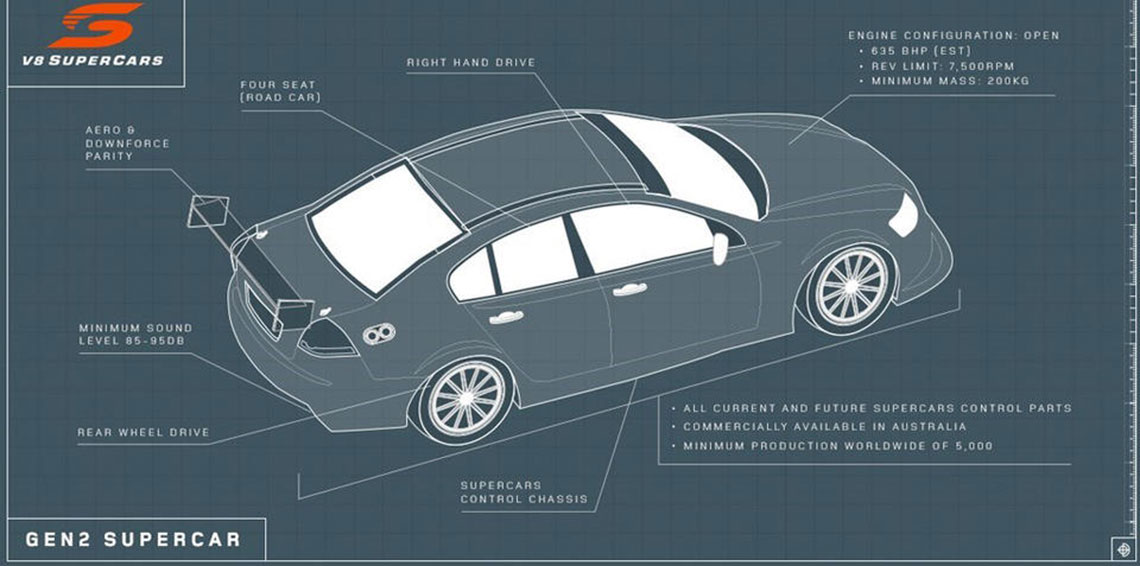The Gen2 Supercar Regulations in detail
The 2017 season marks the debut of the Gen2 Supercar regulations, an evolution of the Car of the Future (or New Generation) era, and the next phase of growth for the Supercars Championship.
What is Gen2?
Gen2 is a set of technical and eligibility rules designed to open up the Supercars Championship to different body shapes and engine configurations outside of the currently mandated 5.0-litre V8.
With the auto industry downsizing and turbocharging engines in search of better fuel economy and power, Supercars released its blueprint for 2017 and beyond in 2014. This 2017 White Paper revealed a set of guidelines designed to be more relevant to modern-day motoring. The hope being to secure more manufacturer interest and appeal to those without a suitable eight-cylinder engine in their production line.
What does Gen2 mean for the Supercars category?
The Gen2 Supercar is seen as the next stage in future-proofing the sport. It follows the implementation of the new generation V8 Supercar in 2013, which ended Holden and Ford’s exclusivity on the grid and opened the door for the arrival of Mercedes, Nissan and Volvo.
The 2017 blueprint opens up the way for smaller turbo-charged six or four cylinder engines to compete alongside the current V8 engines. The requirement that all cars be four-door sedans has also been lifted, paving the way for two-door coupes to enter the series for the first time.
What makes a car eligible for competition under the Gen2 program?
The base Gen2 Supercar guidelines stipulate an eligible car must:
- must be publicly available for sale in Australia;
- is front engine;
- be right hand drive;
- have a minimum production volume of 5000 cars of the same body shape worldwide.
The race car version must:
- run the ‘Car of the Future’ chassis and specified control components, and be subject to engine and aero parity rules;
- be rear wheel drive;
- accurately reflect the look of the road car;
- be powered by an engine configuration, be that 4, 6 or 8 cylinder (or other) that does not exceed the Supercars accumulated engine power output and weighted average;
- be subject to current engine and aero parity rules.
The Gen2 Supercar regulations will also require any new engine to reach a minimum noise level of 85 decibels up to the legal maximum of 95 dB, matching the current Supercars.
Supercars estimate as many as 60 different models of road going cars are currently available in Australia that have the potential to fit the Car of the Future platform.
Does Gen2 spell the end for V8s?
It is expected the majority of teams will remain in their current configurations in the foreseeable future. Although new engines and bodies will be introduced, it also highly unlikely the V8 will disappear altogether due to the large investment placed in the package.
Supercars’ technical staff believe the most likely configuration to challenge the current five-litre V8s is a twin turbo V6 with an engine capacity of between 3.5 and 3.8 litres. For parity purposes this will be restricted to a maximum of 3.85 litres with electronically limited boost.
Has any team or manufacturer committed to the Gen2 program?
While no team or manufacturer has taken up the Gen2 option for this year’s Supercar championship, several manufacturers have production based twin-turbo V6 race engines that could be adapted to the Gen2 Supercar regulations – most notably, GM, Ford and Nissan.
So far, only Holden has declared that it will take advantage of the new Gen2 Supercar regulations with a twin turbo V6 when it swaps to an imported Commodore replacement in 2018. GM Racing in America is developing a V6 turbo for use in the new Commodore.
Supercars is also currently dyno testing its own V6 turbo as part of the introduction of the Gen2 rules.
Related posts
Looking Back to Go Forwards: the Relationship Between Group A and Gen 2 Part 1
Looking Back to Go Forwards: the Relationship Between Group A and Gen 2 Part 2
V8 Supercars reveal draft Gen2 regulations
V8 Supercars reveal 2017 blueprint

